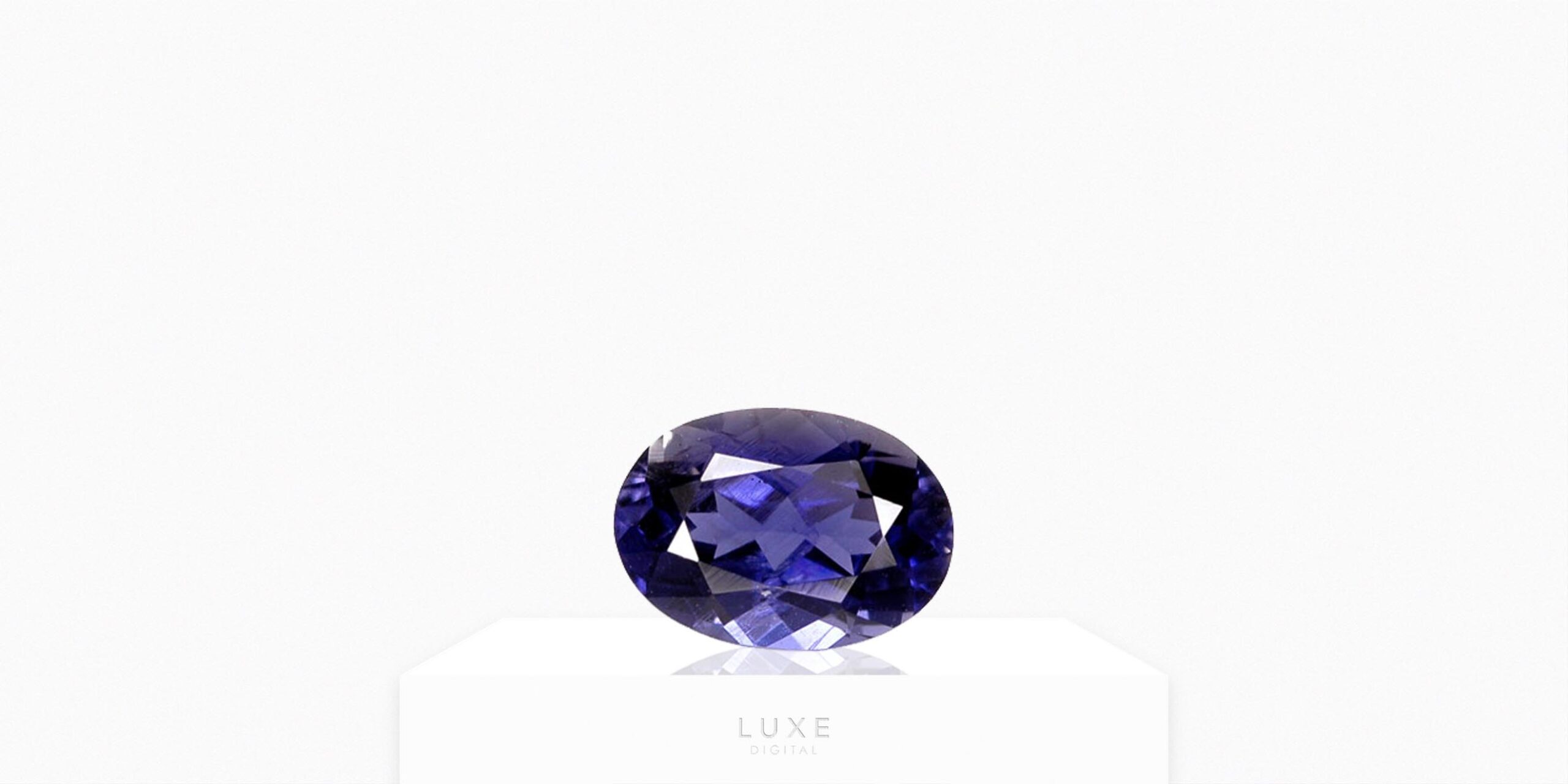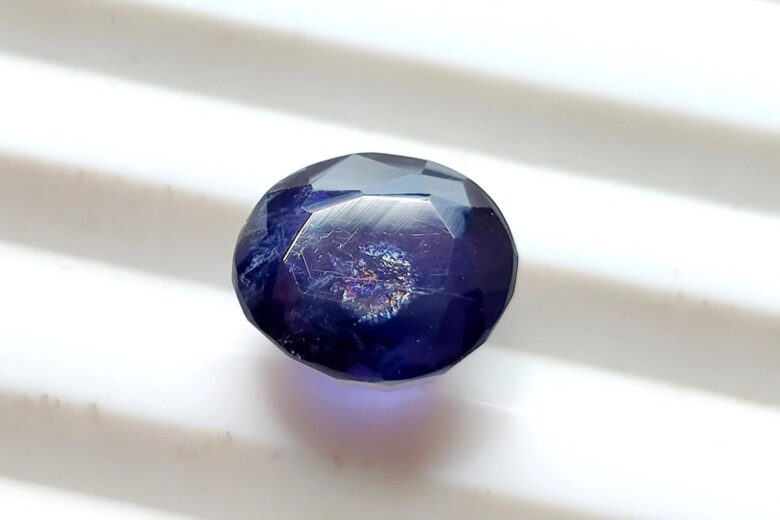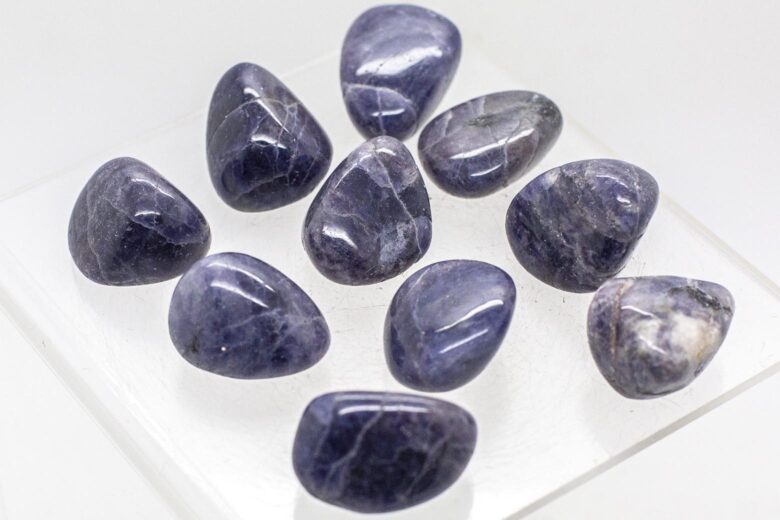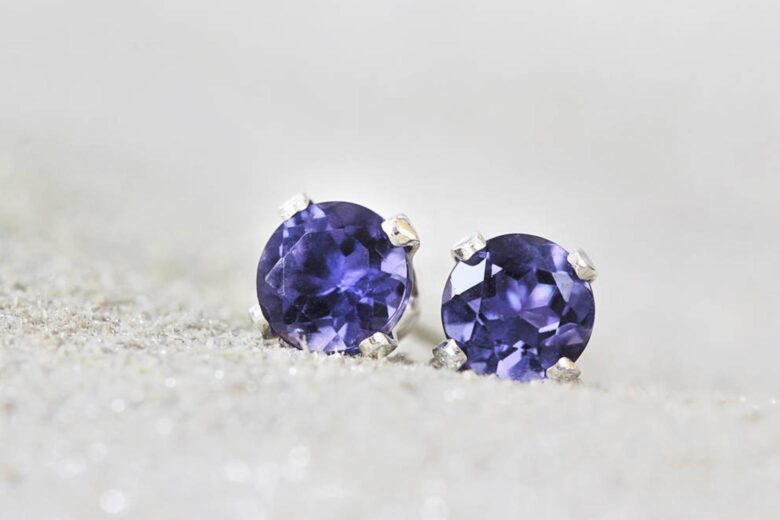
Often mistaken for desirable blue gemstones like sapphire or tanzanite, iolite is the more modestly priced blue gem that deserves a place in every connoisseur’s collection. The majestic violet-blue hues symbolize hope and bring on heightened intuition. The optical effects of iolite are sure to captivate those who set sight on them.
Known as the compass stone, iolite will help you navigate along your spiritual journey and calm you when your path gets rough. Throughout history, iolite has held great significance amongst different cultures as a sunstone and healing stone to mystics and alternative healers.
Iolite can add the right amount of sparkle to your jewelry pieces without breaking the bank. Sometimes referred to as the water sapphire, iolite has many fascinating traits that we will take you through.

| Iolite Colors | Blue, violet, grey, colorless |
| Zodiac Signs | Libra, Sagittarius, and Taurus |
| Hardness Scale | 7-7.5 on Mohs Scale |
| Mineral Class | Codierite |
| Symbolism | Intuition |
What is Iolite
Iolite is a gemstone of silicate mineral variety cordierite. It is made up of the chemical elements magnesium, iron, and aluminum. Iolite is known as cordierite (named after the French geologist Pierre Cordier who first studied it) in mineralogy.
In gemology, cordierite trades as iolite which was named from the Greek words “ios” and “lithos” meaning violet stone. Another older name given to iolite is dichroite which means two-colored rock in Greek. This is in reference to the pleochroic nature of iolite gemstones.
Iolite is a fairly durable gemstone, rating 7-7.5 on the Mohs hardness scale. However, it is not as durable as sapphires, topaz, and diamonds. When set in jewelry that is high impact like rings and bracelets, special care should be taken to prevent damage to the stone.
What does Iolite look like
Iolite is a violet-blue to gray, yellow, or colorless gemstone with a vitreous luster. It is a pleochroic gem which means that it displays different colors when viewed from different angles. Iolites that appear violet or blue in color from one angle often display yellow, gray, colorless, light, or dark violet pleochroic colors from another angle. The presence of iron in the mineral structure of Iolite gives it a gorgeous blue hue. Inclusions in the iolite gemstones lead to attractive cat-eye or aventuresence effects.
Fine iolite is known for its naturally beautiful blue and violet hues. Unlike blue topaz, sapphire, and tanzanite which are often treated in some way, iolite is not usually treated. Some iolite gemstones also appear gray or colorless and if gemologists were able to enhance them to produce more brilliant hues then they certainly would do so. The chemistry of iolite however doesn’t allow it to be treated as it cannot tolerate high temperatures.
The value of Iolite
The value of iolite has not been developed in the gem trade, therefore its price is low. You should consider the 4 C’s when picking out the best iolite to add to your gemstone collection.
Carat
Iolites range in size from 1 to 10 carats. Fine iolites over 5 carats are somewhat rare in the market. Most iolites are 2 carats or smaller.
Color
Iolites are often used as blue gem substitutes and rival the allure of tanzanite and blue sapphires at a fraction of the cost. The most desirable colors of iolite are violet-blue to fine blue.
Clarity
Iolite is transparent to translucent with relatively few inclusions. Those iolite gemstones that do contain inclusions are seen as different types of iolite such as cat’s-eye iolite or bloodshot iolite.
Cut
Iolite is cut to highlight the transparency of the gem, therefore it is most often faceted. Its highly pleochroic nature makes it a tricky gem to cut to bring out its most suitable color. Iolites are also cut into cabochons and sometimes made into carvings. Lower quality iolites are cut into beads.

History and mythology of Iolite
Iolite was once known as the Viking’s Compass stone. It was used to guide Viking navigators by helping them locate the sun, which they used to steer their ships. They were able to pinpoint their location by finding the sun using slices of iolite on glare-reducing polaroid lenses on a cloudy day.
Iolite was widely used in jewelry pieces during the 1700s in Europe. Spiritual healers used iolite in rituals and ceremonies across all cultures. They were said to bring about visions and allow shamans to communicate with the spiritual realm.
One of the largest iolite crystals was discovered in Grizzly Creek, Wyoming in 2004, and weighed a record-breaking 24,000 carats.
Iolite’s meaning and symbolism
Known as the compass stone, iolite is said to guide the wearer of the stone on a journey of self-discovery. Those looking to gain clarity about their dreams keep iolite close by at night. Many believe that this gemstone aids them to unlock their creativity and fulfill their life purpose. The calming blue hues of iolite give hope to the user and promote peace and tranquility.
Where does Iolite come from
Iolite is found in pelitic rocks mined across the world in countries like India, Sri Lanka, Tanzania, Madagascar, and Namibia. Other areas where iolite is found include parts of the USA, Brazil, Canada, and Australia.

Iolite and Zodiac signs
Those born under the zodiac signs Libra, Sagittarius and Taurus can benefit from using iolite as their birthstone. These violet crystals are said to bring strong intuitive powers to the user and encourage imagination and clear dreams. Those looking to travel will benefit from using iolite as a talisman to protect them along the way.
Iolite gemstone family
Iolite is from the cordierite mineral family. The structure of cordierite is similar to that of beryl.
Different types of iolite:
Cats Eye Iolite
Iolite that contains long parallel tubular inclusions allow for the phenomenon of chatoyancy or the cat-eye effect. These stones are cut into cabochons and are rare versions of iolite.
Bloodshot Iolite
Iolite that contains several metallic, plate-like inclusions is cut in a way that displays the effect known as aventurescence. The brown or red hematite inclusions give rise to the bloodshot variety of iolite. This type of iolite is rare and often sought out by gem collectors.
Iolite gemstone uses
Cordierite is sometimes used to make ceramic parts for catalytic converters. In the gem and jewelry trade iolite is used to fashion beautiful pieces of jewelry that contend among the best of the blue gems.
Tumbled iolite stones are used in alternative and crystal healing. They are placed at different chakra points to cleanse and balance the energies.
Iolite is also used as a gemstone in celebrating a twenty-first wedding anniversary.
Frequently asked questions about Iolite gemstone
What is Iolite good for?
Iolite is a blue gemstone that is said to bring about balance and hope to its wearer. Iolite is used to enhance one’s clarity and strengthen our resolve.
Is Iolite an expensive stone?
Iolite is not an expensive stone. Fine stones between 1 and 5 carats are more common and affordably priced. Larger stones between 5 and 10 carats are more expensive, but not as expensive as other blue gems like tanzanite or sapphire.
What chakra is Iolite good for?
Iolite is good for the third-eye chakra to which it is closely connected. It is said to boost our intuition and the way we relate to ourselves and those around us. The crown chakra which sits above the third-eye chakra can also benefit from iolite. It is used to connect one with the spirit realm. For the throat chakra, iolite can incite clear communication.
Is Iolite rare?
In general, iolites are not rare gemstones. However, the finer high-quality iolites over 5 carats that have good clarity and strong coloring can be hard to find and therefore more expensive than the more common variety of iolite.

